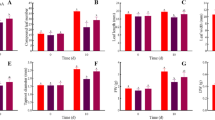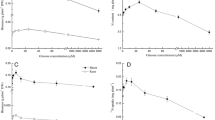Abstract
Amino acid loss from the roots of 25-day-old, sterile and non-sterile sand-grown forage rape plants, was determined over periods of up to 3.5 hours. Amino acid accumulation in the root-zone of sterile plants was concentration-dependent giving a convex accumulation profile. Amino acid levels in the root zone of non-sterile plants rapidly attained steady state values. Microbial assimilation of amino acids within the root zone appeared to lower amino acid concentrations, resulting in an underestimation of rates of amino acid loss from roots. The concentrations of most amino acids were higher after selected amino acids were supplied to the root zone. The response to exogenous acids was dependent on the concentration and composition of the acids added. Addition of a mixture containing ASN, GLN and GABA, each at 0.25 mM resulted in a greater increase in individual and total acid levels compared with a mixture containing ALA, SER, GLY and THR at the same concentration. Apparently, amino acids supplied exogenously competed with acids lost from the plant, by providing an alternative nutrient source for root zone micro-organisms. Addition of glucose and citric acid had a similar effect to addition of ALA, SER, GLY and THR, but were less effective than ASN, GLN and GABA at all concentrations tested. The nitrogen-rich amino acids ASN and GLN, and the γ-amino acid, GABA, appeared to compete more effectively with plant-derived acids than did ALA, SER, GLY and THR, the most abundent constituents of the plant-derived acids, which had the highest calculated rates of microbial consumption. Therefore, although bacterial consumption showed a dependence on amino acid concentration, a degree of selectivity for nitrogen-rich acids and gaba was also apparent.
Similar content being viewed by others
Abbreviations
- ALA:
-
alanine
- ASP:
-
aspartic acid
- ASN:
-
asparagine
- GABA:
-
γ-aminobutyric acid
- GLU:
-
glutamic acid
- GLN:
-
glutamine
- GLY:
-
glycine
- HIS:
-
histidine
- ILE:
-
isoleucine
- LEU:
-
leucine
- LYS:
-
lysine
- MET:
-
methionine
- PHE:
-
phenylalanine
- SER:
-
serine
- THR:
-
threonine
- TRP:
-
tryptophan
- TYR:
-
tyrosine
- VAL:
-
valine
- CIT:
-
citric acid
- GLC:
-
glucose
- DW:
-
dry weight
References
Forbisher M 1970 Fundamentals of Microbiology, 8th edition. W B Saunders Company, Philadelphia, USA. pp 51–54.
Glaser T A, Godel H G, Albers S and Foeldi P 1985 An ultra rapid and sensitive high-performance liquid chromatographic method for determination of tissue and plasma free amino acids. Anal. Biochem. 151, 142–152.
Hale M G and Moore L D 1979 Factors affecting root exudation II: 1970–1978. Adv. Agron. 31, 93–124.
Hewitt E J 1952 Sand and Water Culture Methods used in the Study of Plant Nutrition. In Technical Communication No 22 of the Commonwealth Bureaux of Horticulture and Plantation Crops, East Malling, Maidstone, Kent. pp 174–180. Comonwealth Agricultural Bureaux, UK.
Klein D A, Frederick B A, Biondini M and Trlica M J 1988 Rhizosphere microoganism effects on soluble amino acids, sugars and organic acids in the root zone of Agropyron cristatum, A. smithii and Bouteloua gracilis. Plant and Soil 110, 19–25.
Larsen P O 1980 Physical and chemical proporties of amino acids. In The Biochemistry of Plants Volume 5, Amino Acids and Derivatives. Ed. B J Miflin. pp 225–269. Academic Press, New York, USA.
Miflin B J and Lea P J 1990 The Biochemistry of Plants Volume 16, Intermediary Nitrogen Metabolism. Eds. B J Miflin and P J Lea. Academic Press, San Diego, USA. 402 p.
Misaghi I J 1982 Physiology and Biochemistry of Plant-Pathogen Interactions. Plenum Press, New York and London, USA. 287 p.
Nelson E B 1990 Exudate molecules initiating fungal responses to seeds and roots. Plant and Soil 129, 61–73.
Odham G, Tunlid A, Valeur A, Sundin P and White D C 1986 Model system for studies of microbial dynamics at exuding surfaces such as the rhizosphere. Appl. Environ. Microbiol. 52, 191–196.
Rovira A D 1969 Plant root exudates. Bot. Rev. 35, 35–57.
Shepherd T and Davies H V 1993 Carbon loss from the roots of seedlings of forage rape (Brassica napus L.) following pulse-labelling with 14CO2. Ann. of Bot. 72, 155–163.
Shepherd T and Davies H V 1994 Patterns of short-term amino acid accumulation and loss in the root-zone of liquid-cultured forage rape (Brassica napus L.). Plant and Soil 158, 99–109.
Smith G S, Johnston C M and Cornforth J S 1983 Comparison of nutrient solutions for growth of plants in sand cultures. New Phytol. 94, 537–548.
Sundin P, Valeur A, Olsson S and Odham G 1990 Interactions between bacteria-feeding nematodes and bacteria in the rape rhizosphere: effects on root exudation and distribution of bacteria. FEMS Microbiol. Ecol. 73, 13–22.
Svenningson H, Sundin P and Liljenberg C 1990 Lipids, carbohydrates and amino acids exuded from the axenic roots of rape seedlings exposed to water-deficit stress. Plant, Cell, Environ. 13, 155–162.
Author information
Authors and Affiliations
Rights and permissions
About this article
Cite this article
Shepherd, T., Davies, H.V. Effect of exogenous amino acids, glucose and citric acid on the patterns of short-term accumulation and loss of amino acids in the root-zone of sand-cultured forage rape (Brassica napus L.). Plant Soil 158, 111–118 (1994). https://doi.org/10.1007/BF00007923
Received:
Accepted:
Issue Date:
DOI: https://doi.org/10.1007/BF00007923




